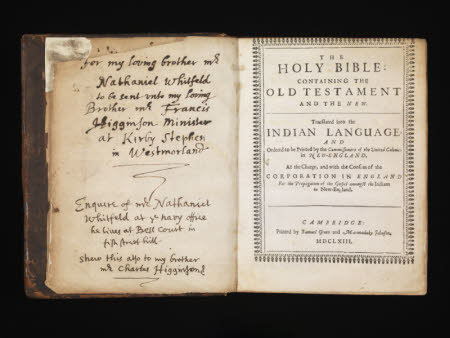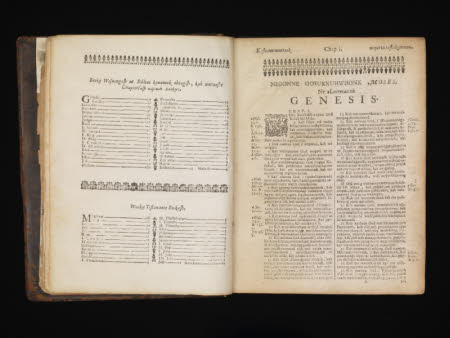The Holy Bible: containing the Old Testament and the New. Translated into the Indian language, and ordered to be printed by the Commissioners of the United Colonies in New-England, at the charge, and with the consent of the Corporation in England for the propagation of the Gospel amongst the Indians in New-England.
John Eliot (1604 - 1690)
Category
Books
Date
1663
Materials
Paper, ink, calf binding
Measurements
18.7 x 14.8 x 8.2 cm
Place of origin
Cambridge
Order this imageCollection
Blickling Hall, Norfolk
NT 3094668
Caption
This unusual translation of the Bible provides us with a remarkable window into early North American colonial history. It was written in Wôpanâak, an Algonquian language spoken by some native peoples of the east coast, before European settlers brought about the destruction of existing cultures. This lost language is now being revived with the help of this publication, which effectively provides a key to its reconstruction. The book was mainly the work of a Puritan missionary named John Eliot (1604–90) and was used to encourage the Native American population to convert to Christianity. Around 1,000 copies were printed, but few survive today, and this copy, from the library at Blickling Hall in Norfolk, includes information about its many early owners. Soon after it was printed, it was sent by John Higginson, a minister of Salem, Massachusetts, to his brother Francis, the rector of Kirkby Stephen in Westmorland (Cumbria), to show the continued spread of Christianity across the world.
Summary
Full description
This translation in the Algonquian Wôpanâak language was the first Bible printed in North America and the earliest example of a complete Bible in a new language for evangelical work. The Puritan missionary John Eliot worked on it for ten years with help from native speakers John Sassamon, Cockenoe and Job Nesuton, and around 1000 copies were printed on a press provided by the first Protestant missionary society, the ‘Corporation for the Propagation of the Gospel amongst the Indians in New England’. Many surviving copies have inscriptions to Eliot’s supporters, and it was clearly intended to attract funding as well as to educate American converts. Today it has a new value in helping to revive a language destroyed by European settlers. Contemporary inscriptions in the Blickling copy provide a glimpse of settler families who were moving back and forth between America and England. It was sent by John Higginson, Minister of Salem, Massachusetts, to his brother Francis Higginson, Rector of Kirkby Stephen, Westmorland. On its way, the book passed through the hands of John’s brother-in-law Nathaniel Whitfeld, who lived in Fish Street Hill near the seat of the Great Fire of 1666 and was a contemporary of Samuel Pepys in the Navy Office. By the early eighteenth century, the Bible was in the hands of Sir Richard Ellys, connoisseur and Biblical scholar, who owned over 40 Bibles in different versions and languages. He had links with American settlers through London’s dissenting congregations and was courted by Harvard who hoped to acquire his library. (Nicola Thwaite 2021)
Bibliographic description
[1208] p. ; 4to. Running number: 2684. Possibly wanting initial blank leaf (A1); wanting initial blank leaf (³A1) of New Testament. Provenance: manuscript inscription on first front fly-leaf: "Daniel Whitfeld March 20th [16]65" [Daniel Whitfield not identified, but see notes below on other members of the Whitfeld/Whitfield family]. Manuscript initial on recto of second front fly-leaf (possibly the initial blank leaf A1): "M." [i.e. catalogue code of John Mitchell (ca. 1685-1751), librarian to Sir Richard Ellys (1682-1742)]; with Mitchell's manuscript code at foot of leaf: "ε'." [i.e. epsilon' = Greek number 5]. Manuscript inscriptions on verso of second front fly-leaf (opposite title page): [1] "For my loving brother Mr Nathaniel Whitfeld to be sent unto my loving brother Mr Francis Higginson Minister at Kirby Stephen in Westmorland" and [2] "Enquire of Mr Nathaniel Whitfeld at ye navy office he lives at Bell Court in fish street hill. Shew this also to my brother Mr Charles Higginson". The anonymous sender was John Higginson (1616-1708); he sent the book from Massachusetts to England immediately after its publication. John Higginson became pastor of the First Church of Salem, Massachusetts in 1659. He was the eldest son of the Leicestershire clergyman Francis Higginson (1586?-1630), who was appointed minister by the Massachusetts Bay Company in 1629, and became first Teacher of the First Church of Salem, founded in 1629, where he devised the 'Salem Covenant'. John sent the book to his brother Francis Higginson (1618-1673), who taught in Cambridge (Massachusetts) and had returned to Europe in 1639 to study at Leiden, and was appointed vicar at Kirkby Stephen, Westmorland, in 1648. John Higginson also worked as a school-master in Guilford, Connecticut, where in 1641 he married Sarah, daughter of Henry Whitfeld or Whitfield (1590/91-1657). Henry was the leader of a group of English Puritans who had emigrated to New England in 1639, where he purchased land for the township of Menumkatuck (renamed Guilford in 1643) and served as its minister for 11 years. John Higginson succeeded his father-in-law Henry as pastor of Guilford church, and also learnt to preach in the local native language. John directed the bible to Francis through his brother-in-law Nathaniel Whitfeld (1626/7-1696), son of Henry Whitfeld, in London. Nathaniel had emigrated with his parents to New England in 1639, but is known to have returned to England at some point and worked at the Navy Office from 1663-1692, at the same time as Samuel Pepys. Charles Higginson (1628?-1677?), the third brother in John's inscription, was a sailor who had lived in New Haven, Connecticut until at least 1649 but was now in Stepney and described as in the Jamaica trade. Binding: seventeenth-century full calf, sewn on four tawed leather supports; gilt roll pattern and double blind fillet border, with gilt foliate cornerpiece stamps; single blind fillet along board edges. Rebacked and repaired in tan calf. Original spine retained (worn), with blind fillet and roll decoration alongside the four raised bands and at head and foot. Without pastedowns. Edges stained red. Shelved in box.
Makers and roles
John Eliot (1604 - 1690), translator Samuel Green (1615 - 1702), printer Marmaduke Johnson (d.1674), printer Society for Propagation of the Gospel in New England , publisher Company for Propagation of the Gospel in New England and the Parts Adjacent in America , publisher United Colonies of New England. Commissioners , publisher

